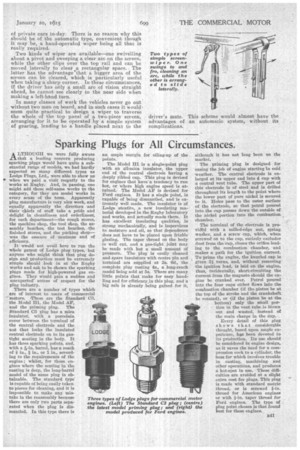Sparking Plugs for All Circumstances.
Page 25

If you've noticed an error in this article please click here to report it so we can fix it.
A LTHOUGH we were fully aware 1-Ithat a leading concern producing sparking plugs would have quite a substantial range of models, we had hardly expected so many different types as Lodge Plugs, Ltd., were able to show us • when we paid a visit recently to the works at Rugby. And, in passing, one might add these self-same works to the category, for they are model works in every sense of the term. Apparently plug manufacture is very nice work, and equally apparently the directors and their chiefs of staff take a pride and delight in cleanliness and orderliness, for each department—the rough stores, the machine shop, the tool shop, the assembly benches, the test benches, the finished stores, and the packing shop— was the essence of neatness and of efficiency.
It weuld not avail here to run the whole gamut of Lodge plug types, but anyone who might think that plug design and production must be extremely simple should look in at the Rugby works and ask to be shown the sparking plugs made for high-powered gas engines. They would gain a sudden and unexpectedaccess of respect for the plug industry.
There are a number of types which are of interest to users of commercial motors. -These are the Standard 03, the Model H1, the Model AP, and the priming plug. The Standard 03 plug has a mica insulator, with a porcelain Cover between the terminal of the central electrode and the nut that locks the insulated central electrode on to its gastight seating in the body. It has three sparking points, and, with a h-in. barrel, has a reach of a in., a in., or 1 in., according to the requirements of the engine ; whilst, for those engines where the seating in the casting is deep, the long-barrel model of the same plug is obtainable. The standard type is capable of being easily taken to pieces for cleaning, and it is impossible to make any mistake in the reassembly because there are only two parts separated when the plug is dismantled. In this type there is an ample margin for oiling-up of the points.
The Model H1 is a single-point plug with an allonica insulator, the upper end of the central electrode having a deeply ribbed cap. This plug is devised for engines that have' a tendency to run hot, or where high engine speed is -attained. The Model AP is devised for Ford engines. It has a single point, is capable of being dismantled, and is extremely well made. The insulator is of Lodge steatite, a new insulating material developed in the Rugby laboratory and works, and actually made there. It has excellent insulating qualities, is strong mechanically, and is impervious to moisture and oil, so that dependence does not have to be placed upon friable glazing. The taper thread on the body is well cut, and a gas-tight joint may be made with but a small amount of pressure. The plug is easily cleaned and spare insulators with centre pin and terminal are supplied at 2s. 6d., the complete plug costing 4s., a long-reach model being sold at 5s. There are many little points that make for easy handling and for efficiency in this plug, and a big sale is already being gained for it,
although it has not long been on the market.
The priming plug is designed for easing the job of engine starting in cold weather. The central electrode is enlarged at its upper end into d cup with a central vent tube. The upper part of this electrode is of steel and is drilled throughout its length to the point where the lower part of pure nickel is secured to it. Holes pass to the outer surface of the electrode, so that petrol poured into the cup passes down the outside of the nickel portion into the combustion chamber.
The terminal of the electrode is pro
vided with a milled-edge nut, spring washer, and a screw cap, which, when screwed on to the cup, entirely excludcs'. dust from the cup, closes the orifice leading to the combustion chamber, and makes a path for the ignition current. To prime the engine, the knurled cap is given 2i turns, and, without removing the ignition lead, is laid on the engine, thus, incidentally, short-circuiting the current from the magneto should the engine be cranked over. Petrol poured into the four cups either flows into the combustion chamber (if the piston be at the top of the stroke and the crankshaft be rotated), or (if the piston be at the bottom) only the small portion in the vent tube is blown out and wasted, instead of the main charge in the cup. .
Every detail of this plug
sh o ws that considerable thought, based upon ample experience, has been devoted to ite production. Its use should be considered in engine design, • as it saves the need for a comPression cock to a cylinder, the boss for which involves trouble in casting, machining and other operations, and produces a hot-spot in use. These difficulties are avoided at a slight extra cost for plugs. This plug is made with standard metric thread, or is screwed fin. thread for American engines or with Fin, taper thread for Ford engines. The type of plug point chosen is that found best for these engines.,






























